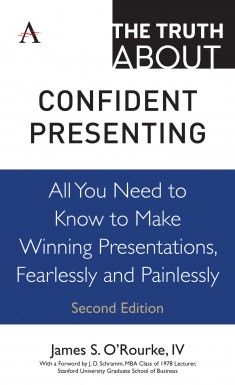The Truth about Confident Presenting
All You Need to Know to Make Winning Presentations, Fearlessly and Painlessly
By James S. O'Rourke
IV
Other Formats Available:
- About This Book
- Reviews
- Author Information
- Series
- Table of Contents
- Links
- Podcasts
About This Book
Accomplished public speakers know that just a few enduring principles govern the key to success. Based on scientific evidence and years of careful observation of highly successful public speakers, James O’Rourke has gathered 51 basic truths about confident presenting, organized into ten easily mastered categories in ‘The Truth about Confident Presenting’. Current relevant examples and specific instructions on how to apply these truths form the centrepiece of each brief chapter. Everything you need is right here – from audience research to topic selection, organization patterns, forms of evidence, principles of persuasion, delivery techniques, nonverbal mannerisms, anxiety and event management.
Reviews
Author Information
James S. O’Rourke IV, teaching professor of management and the Arthur F. and Mary J. O’Neil Director of the Eugene D. Fanning Center for Business Communication at the University of Notre Dame, USA, is a widely regarded consultant among ‘Fortune 500’ companies in the United States and around the world.
Series
Table of Contents
Contents; Part I: Some Initial Truths; 1. Public Speaking Is Not Easy, but It’s Certainly Doable; 2. The Key to Success Is Preparation; 3. Rehearsal Is Essential; 4. Emulating Good Speakers Makes You Better; 5. Establish Goals for Your Presentation; 6. A Presentation Is a Learning Occasion; Part II: The Truth about Getting Ready to Speak; 7. Talk Is the Work; 8. Know What Your Audience Is Looking For; 9. There Is a Difference between Speaking and Writing; 10. Preparing a Presentation Is a Relatively Simple Process; 11. Begin by Analyzing Your Audience; 12. Know about Your Audience; Part III: The Truth about What Makes People Listen; 13. Understand What Makes People Listen; 14. Your Speaking Style Makes a Difference; 15. Answer the Questions Listeners Bring to Your Presentation; 16. Listening Matters; 17. Being an Active Listener Brings Real Benefits; 18. You Can Overcome the Barriers to Successful Communication; Part IV: The Truth about Developing Support for Your Presentation; 19. Develop Support for Your Presentation; 20. Understand the Power of Your Content; 21. The Kinds and Quality of Evidence Matter to Your Audience; 22. Structure Can Help Carry an Inexperienced Speaker; 23. Find Support for Your Presentation; 24. Use the Internet to Support Your Presentation; Part V: The Truth about Getting Up to Speak; 25. Select a Delivery Approach; 26. Your Introduction Forms Their First Impression; 27. Begin with a Purpose in Mind; 28. Keep Your Audience Interested; 29. Conclusions Are as Important as Introductions; 30. Have Confidence in Your Preparation; 31. Repeat the Process as Often as Possible; Part VI: The Truth about Managing Anxiety; 32. All Speakers Get Nervous; 33. Recognize Anxiety Before It Begins; 34. Deal with Nervous Behaviour; 35. Keep Your Nervousness to Yourself; Part VII: The Truth about Nonverbal Communication; 36. Most Information Is Transferred Nonverbally; 37. The Nonverbal Process Can Work for You; 38. Nonverbal Communication Has Specific Functions; 39. Nonverbal Communication Is Governed by Key Principles; 40. Nonverbal Communication Has an Effect on Your Audience; Part VIII: The Truth about Visual Aids; 41. Visual Aids Can Help Your Audience Understand Your Message; 42. Understand Visual Images Before You Use Them; 43. Choose the Right Visual; 44. Use PowerPoint Effectively; 45. Consider Speaking without Visuals; Part IX: The Truth about Handling an Audience; 46. Assess the Mood of Your Audience; 47. Answer the Audience’s Questions; 48. Handle Hostility with Confidence; Part X: The Truth about What Makes a Presentation Work; 49. Know as Much as Possible about the Location; 50. Use the Microphone to Your Advantage; 51. Know Your Limits;
Links
Stay Updated
Information
Latest Tweets



